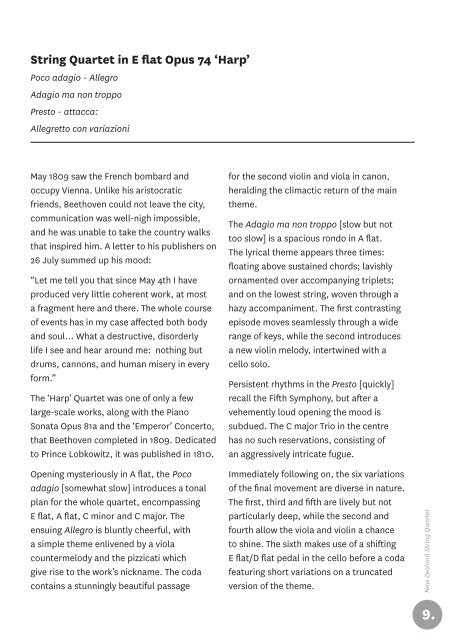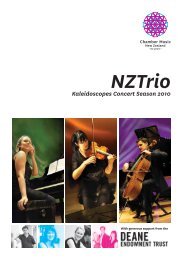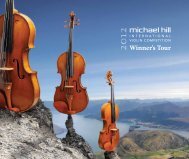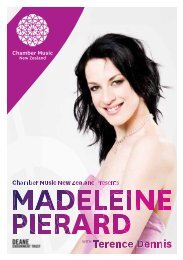BEETHOVEN! - Chamber Music New Zealand
BEETHOVEN! - Chamber Music New Zealand
BEETHOVEN! - Chamber Music New Zealand
Create successful ePaper yourself
Turn your PDF publications into a flip-book with our unique Google optimized e-Paper software.
String Quartet in E fl at Opus 74 ‘Harp’<br />
Poco adagio - Allegro<br />
Adagio ma non troppo<br />
Presto - attacca:<br />
Allegretto con variazioni<br />
May 1809 saw the French bombard and<br />
occupy Vienna. Unlike his aristocratic<br />
friends, Beethoven could not leave the city,<br />
communication was well-nigh impossible,<br />
and he was unable to take the country walks<br />
that inspired him. A letter to his publishers on<br />
26 July summed up his mood:<br />
“Let me tell you that since May 4th I have<br />
produced very little coherent work, at most<br />
a fragment here and there. The whole course<br />
of events has in my case aff ected both body<br />
and soul... What a destructive, disorderly<br />
life I see and hear around me: nothing but<br />
drums, cannons, and human misery in every<br />
form.”<br />
The ‘Harp’ Quartet was one of only a few<br />
large-scale works, along with the Piano<br />
Sonata Opus 81a and the ‘Emperor’ Concerto,<br />
that Beethoven completed in 1809. Dedicated<br />
to Prince Lobkowitz, it was published in 1810.<br />
Opening mysteriously in A fl at, the Poco<br />
adagio [somewhat slow] introduces a tonal<br />
plan for the whole quartet, encompassing<br />
E fl at, A fl at, C minor and C major. The<br />
ensuing Allegro is bluntly cheerful, with<br />
a simple theme enlivened by a viola<br />
countermelody and the pizzicati which<br />
give rise to the work’s nickname. The coda<br />
contains a stunningly beautiful passage<br />
for the second violin and viola in canon,<br />
heralding the climactic return of the main<br />
theme.<br />
The Adagio ma non troppo [slow but not<br />
too slow] is a spacious rondo in A fl at.<br />
The lyrical theme appears three times:<br />
fl oating above sustained chords; lavishly<br />
ornamented over accompanying triplets;<br />
and on the lowest string, woven through a<br />
hazy accompaniment. The fi rst contrasting<br />
episode moves seamlessly through a wide<br />
range of keys, while the second introduces<br />
a new violin melody, intertwined with a<br />
cello solo.<br />
Persistent rhythms in the Presto [quickly]<br />
recall the Fifth Symphony, but after a<br />
vehemently loud opening the mood is<br />
subdued. The C major Trio in the centre<br />
has no such reservations, consisting of<br />
an aggressively intricate fugue.<br />
Immediately following on, the six variations<br />
of the fi nal movement are diverse in nature.<br />
The fi rst, third and fi fth are lively but not<br />
particularly deep, while the second and<br />
fourth allow the viola and violin a chance<br />
to shine. The sixth makes use of a shifting<br />
E fl at/D fl at pedal in the cello before a coda<br />
featuring short variations on a truncated<br />
version of the theme.<br />
<strong>New</strong> <strong>Zealand</strong> String Quartet<br />
9.





